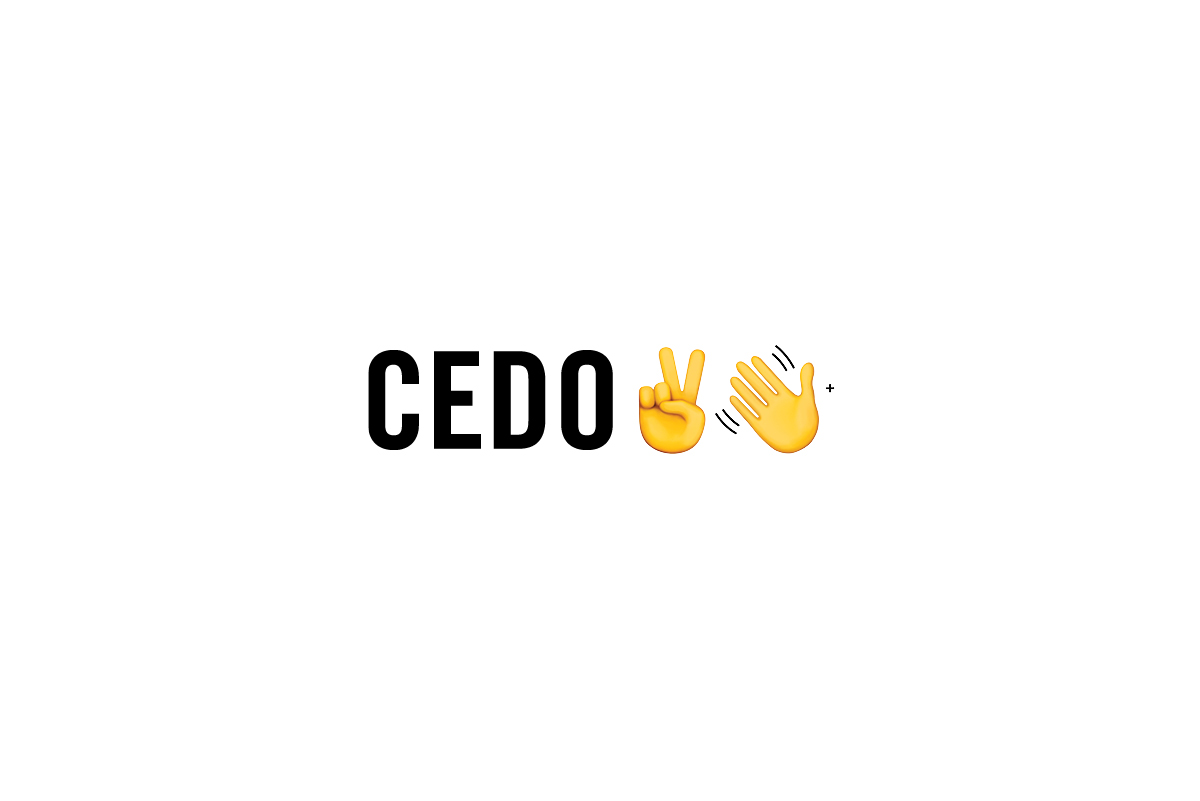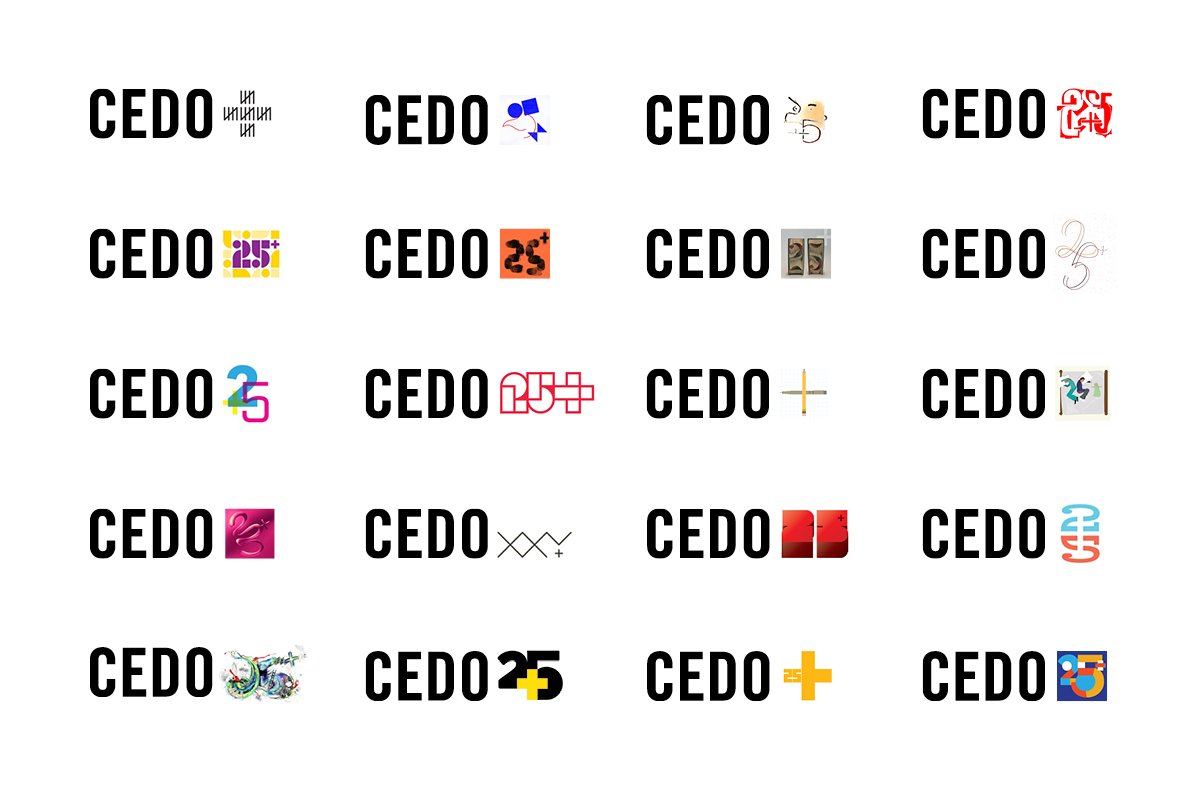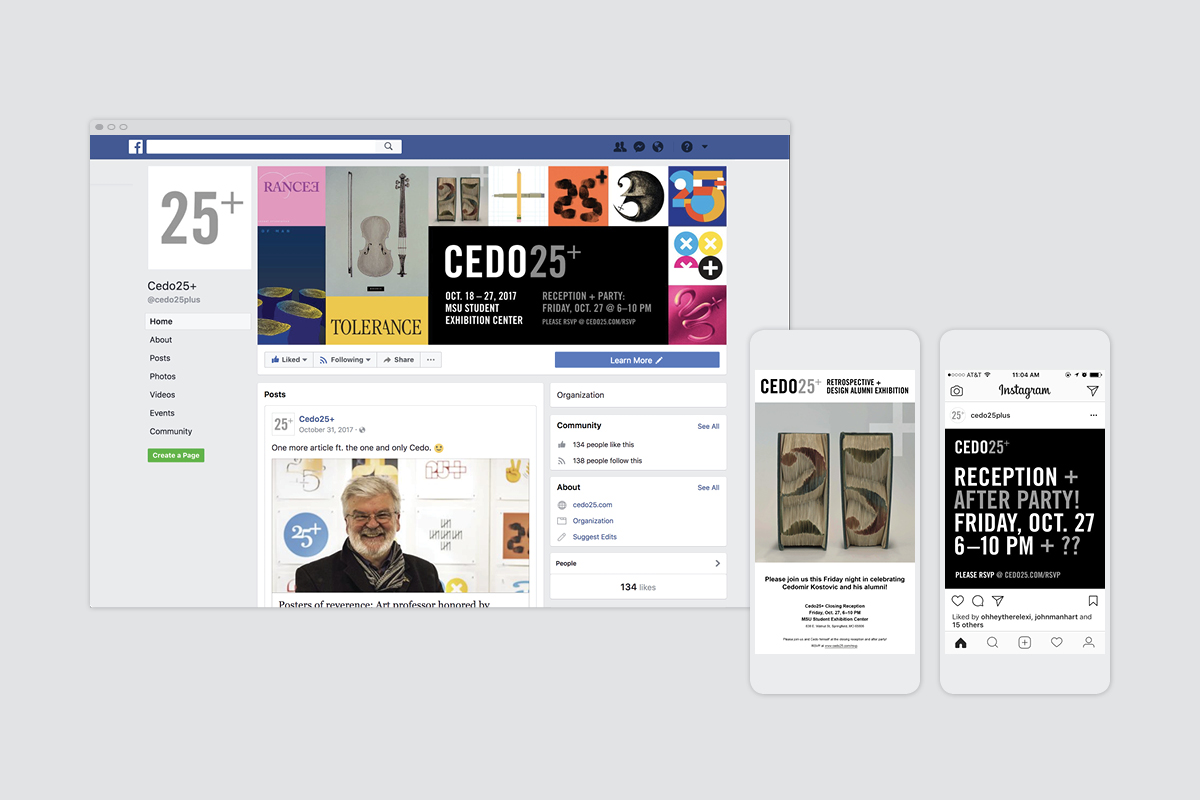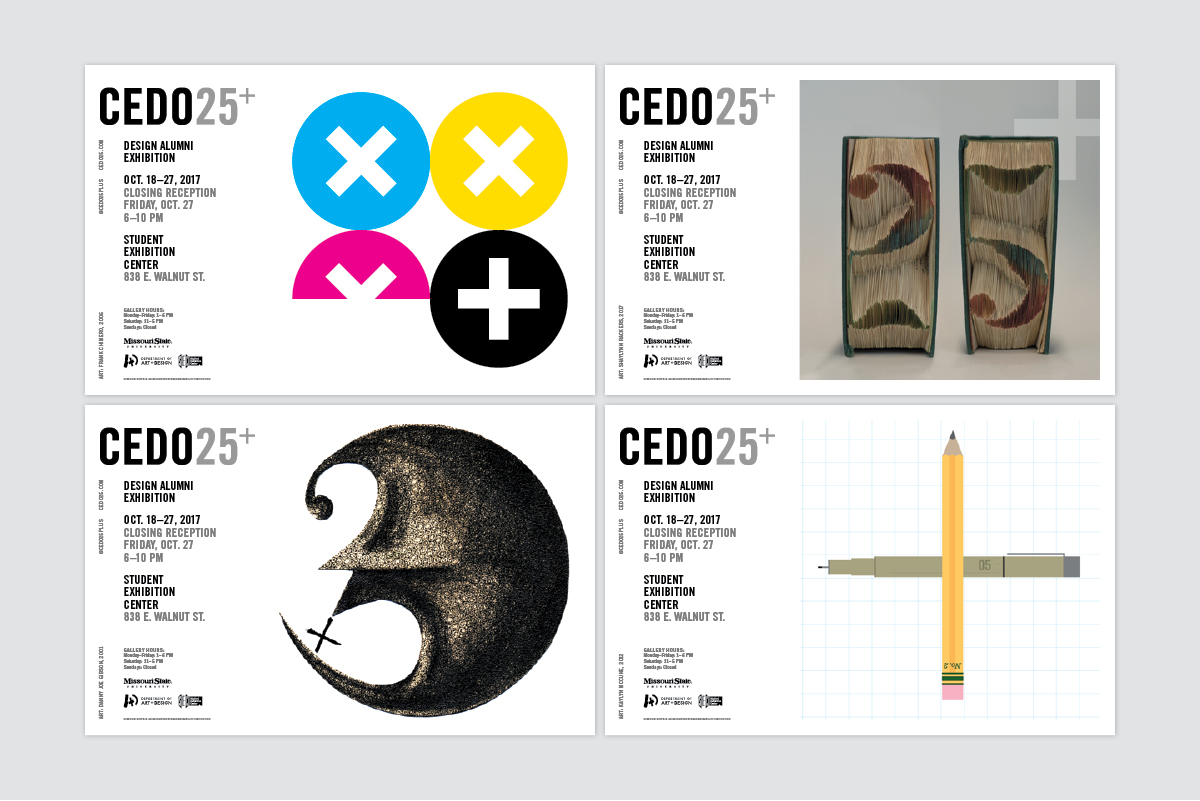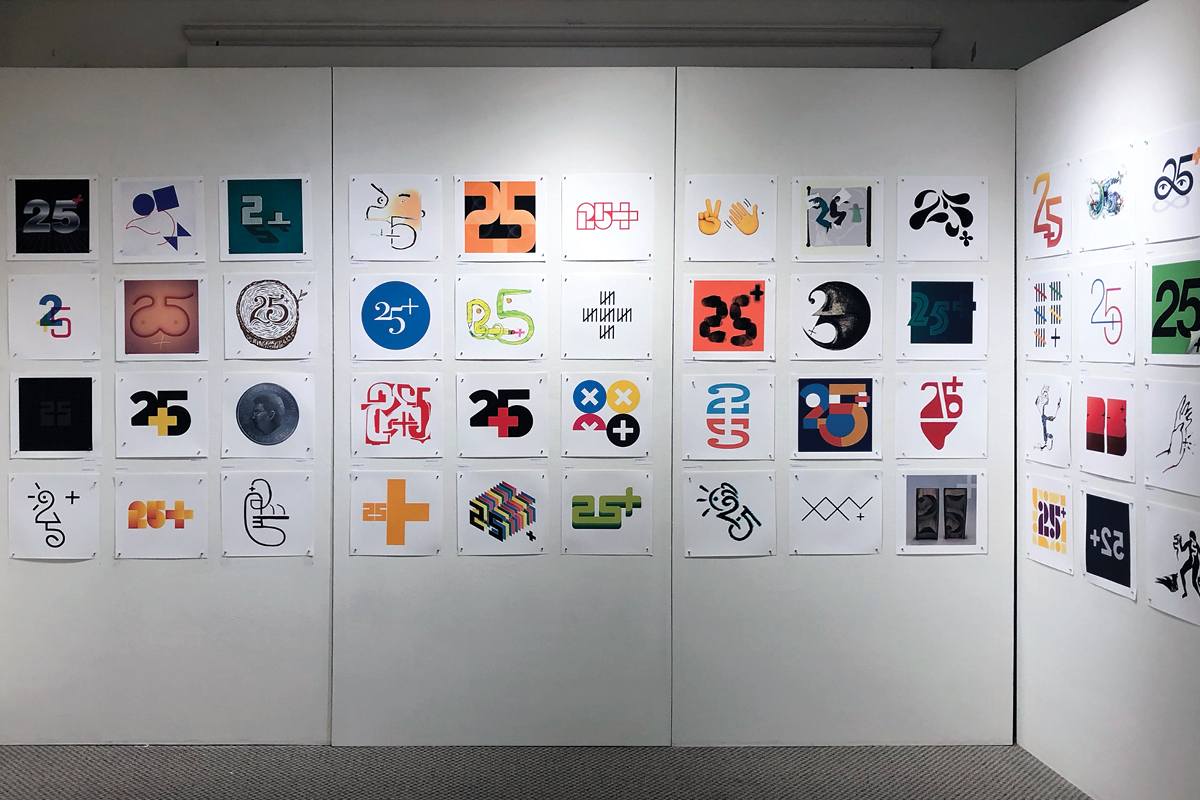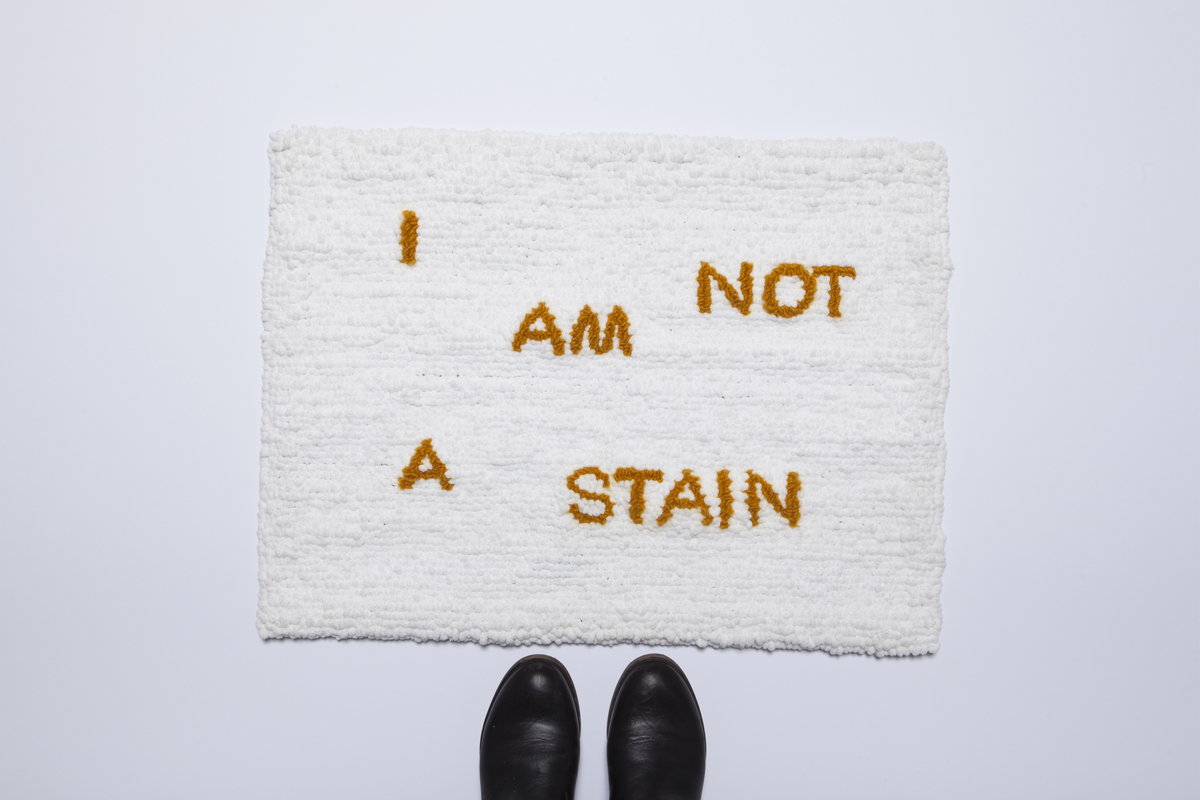I was the lead organizer and designer of Cedo25+, an alumni exhibition that celebrated the career and retirement of Missouri State University design professor Čedomir Kostović. Because Čedo’s personal design practice was in social posters, our primary call for entry asked alumni to submit an original piece of art that addressed social justice issues. We also made the decision to accept client and personal projects that alumni had created in order to encourage all alumni to participate in the capacity that their bandwidth allowed.
As an extra design exercise, we invited alumni to design or illustrate the number “25+” to be used as part of our flexible logo system. Some alumni submitted to only one part of the call for entry while others did all three.
A flexible logo system was designed to accomodate secondary logos featuring alum-designed "25+" art.
Our goal with this exhibition was to design an inclusive and balanced art show that did not exclude any designers on the basis of experience, age, interests, perceived talent or even current occupation. Instead, we wanted to
- Encourage designers to make self-directed work about causes that they were passionate about. Projects
Maximize participation with the understanding that not everyone is privileged to have the time and/or energy to dedicate to unpaid side projects. Some Missouri State design alumni are freelancers with flexible schedules. Others work full time and have children.
- Show the diversity of talent among Čedo’s former students. We decided that Cedo25+ should be an inclusive exhibition, so we deliberately chose not make it judged show, which would have put less-experienced designers at a disadvantage. Anyone was allowed to enter what they wanted—whatever project they were most proud of or whatever they were most passionate about. We trusted our alumni to make that judgement call—even if they wanted to submit anonymously, because we wanted the legacy of Cedo to be about doing good work and holding the world accountable, not about whether or not your name would be attached to it.
- Have fun. Art and design isn’t always fun, and I feel like it’s necessary for it to sometimes be fun. Especially around mid-career, a lot of designers lose their sense of joy for their profession. Burnout is real. I suspect that every designer has been at a point in their careers where they’re at jobs—at agencies, in house, at start-ups, anywhere—that pay the bills but don’t have, creatively, the right projects or the right budget or the right timelines. We wanted to create a space and opportunity for everyone to let go of client expectations and brand guidelines and get back to the love of art that started every single alumni’s careers.
Yellow in America (I AM NOT A STAIN), 2017
What does it mean to talk about race in America?
For my personal submission to the show, I handmade a rug titled Yellow in America (I AM NOT A STAIN). The piece is a commentary on the invisibility and the erasure of the Asian American diaspora in the greater context of how racism is taught in America. During my lifetime leading up to 2020, it has been treated primarily as a Black and White issue. As people with "yellow" skin, Americans of East Asian descent are privileged to not have to face a lot of the overt discrimination that Black, Brown (Latinx, North African, South and West Asians), and Indigenous people face. However, because of this privilege, we are often left out of the race conversation with the assumption that we are equal to White people. That is not our reality.
Racism is not beautiful. It is not produced to perfection. It is raw, and it is ugly and you cannot keep side stepping it.
The Model Minority Myth
Asian Americans are tokenized as the Model Minority and used to oppress “lesser” (heavy emphasis on the air quotes) races in the American caste system. People point to us and say, "If Asians can succeed in [insert area], why can't [insert a darker-skinned race of people] do it?"
It’s messed up, and it often feels like we as Asian Americans are not even allowed to complain because—and I quote—“It’s not that bad.” White people gaslight us and sadly, other minorities often follow their White lead.
Why a rug?
I chose to purposely make this piece not beautiful, because racism is not beautiful. It is not produced to perfection. It is raw, and it is ugly and you cannot keep side stepping it. It is not meant to put on a pedestal. It is a pristine, white welcome mat that dares you to acknowledge it and engage with it without ruining it or sweeping it aside. (Note: Due to accessibility and space issues, this mat could not be placed in front of a doorway at the exhibition as intended.)
My race is a part of American history, period. Like a hooked rug, its fibers are woven meticulously tight yet remarkably loose. One pull of the yarn and the entire rug—a solid month of work—could come undone. The fibers of my being may be different (the white yarn is a voluminous, soft polyester; the yellow is a finely spooled wool), but we share the same American immigrant history of fleeing the poverty and persecution of our motherlands. It is the same oppressive history that was previously subjected to people of Jewish descent, to people of Italian descent, to people of Irish descent and so on and so on, right down to the British Protestants that euthanized and displaced the Indigenous peoples of this colonized land—that kidnapped and enslaved Africans and continued to abuse and kill African of African descent in this country we dare to call Home of the Free. That is our history. That is how I come into the story, and that is the purpose of this piece: To make the design alumni of the Missouri State State University—a university in a 91.16% White midwestern city that benefited from the teachings of Čedomir Kostović, a member of the Yugoslavian diaspora—to make them and our shared community understand the depths of white supremacy… otherwise, what—for the love of God, the Universe, the Flying Spaghetti Monster and all that is good—what was my lifetime of needless work and suffering for?
I need Your help
In this fight against systematic white supremacy, please don’t let me down. Despite all the unknown and unintentional harm you have caused, I choose to forgive you and personally invite you to be the light in these dark times. To quote Anne Frank’s famous words, “It's a wonder I haven't abandoned all my ideals, they seem so absurd and impractical. Yet I cling to them because I still believe, in spite of everything, that people are truly good at heart.”
I believe that.
I believe it with all of my thousands-of-dollars-of-therapy-healed heart. I believe that You—yes, capital Y-o-u—are fully capable of doing the anti-racist, the anti-homophobic, the anti-transphobic, the anti-antireligious work to make the American dream a reality for all.
Yes, all White People
If you do not wish to be identified as a part of American white supremacy system (not to be confused with White Supremacy™)—and I know most of you fall into this category—do not keep calm. Do not carry on. Do something about it. Close your mouth, and instead, open your eyes and ears as wide as your heart. Research. Listen. Reflect. Apologize. Take a deep breath. And then do the work. Every day, show up and do the work. No matter how hard and awkward it is, do the work. And don’t—not for one single second—think about how this will earn you money or fame. Normalize love, not capitalistic hate.
Co-organizers: Čedomir Kostovič, Lucas Roy and Adam Bowlin
Participating alumni: Robert Adams, Charli Barnes, Kory Bingaman, Taylor Bolls, Katherine Botts, Adam Bowling, Philip Cheaney, Frank Chimero, Nathan Cook, Michael Crawford, Richelle Davidson, Maggie Joyce Docking, Chris Escobar, Jason Frazier, Agatha Gallagher, Tyler Galloway, Masha Gerasimchuk-Djordjevic, Danny Gibson, Trevor Gilley, Wesley Hamilton, Shen Chen Hsieh, Alyssa Ilgenfritz, Billy Shayne Johnson, Laura Kemp, Jeff Kern, Jesse Kuhn, Joon Kwun, Kaylyn McCune, Mark Montgomery, Morgan Laura, Josh Nichols, Jesse Nivens, Frank Norton, Aimee Pong, Chandler Reed, Alexis Reid, Megan Ruth, Alex Sanders, Nicole Schwaab-Frietsch, Marty Sellmeyer, Jeremy Shreckhise, Gabrielle Smith, Kelsey Steffes, Andy Towler, Chris Vaughn, Kory Waschick, Doug Wilson, Emily Young and Daniel Zender.
Agency: Studio Mercury



